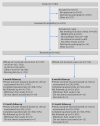Telehealth for patients at high risk of cardiovascular disease: pragmatic randomised controlled trial
- PMID: 27252245
- PMCID: PMC4896755
- DOI: 10.1136/bmj.i2647
Telehealth for patients at high risk of cardiovascular disease: pragmatic randomised controlled trial
Abstract
Objective: To assess whether non-clinical staff can effectively manage people at high risk of cardiovascular disease using digital health technologies.
Design: Pragmatic, multicentre, randomised controlled trial.
Setting: 42 general practices in three areas of England.
Participants: Between 3 December 2012 and 23 July 2013 we recruited 641 adults aged 40 to 74 years with a 10 year cardiovascular disease risk of 20% or more, no previous cardiovascular event, at least one modifiable risk factor (systolic blood pressure ≥140 mm Hg, body mass index ≥30, current smoker), and access to a telephone, the internet, and email. Participants were individually allocated to intervention (n=325) or control (n=316) groups using automated randomisation stratified by site, minimised by practice and baseline risk score.
Interventions: Intervention was the Healthlines service (alongside usual care), comprising regular telephone calls from trained lay health advisors following scripts generated by interactive software. Advisors facilitated self management by supporting participants to use online resources to reduce risk factors, and sought to optimise drug use, improve treatment adherence, and encourage healthier lifestyles. The control group comprised usual care alone.
Main outcome measures: The primary outcome was the proportion of participants responding to treatment, defined as maintaining or reducing their cardiovascular risk after 12 months. Outcomes were collected six and 12 months after randomisation and analysed masked. Participants were not masked.
Results: 50% (148/295) of participants in the intervention group responded to treatment compared with 43% (124/291) in the control group (adjusted odds ratio 1.3, 95% confidence interval 1.0 to 1.9; number needed to treat=13); a difference possibly due to chance (P=0.08). The intervention was associated with reductions in blood pressure (difference in mean systolic -2.7 mm Hg (95% confidence interval -4.7 to -0.6 mm Hg), mean diastolic -2.8 (-4.0 to -1.6 mm Hg); weight -1.0 kg (-1.8 to -0.3 kg), and body mass index -0.4 ( -0.6 to -0.1) but not cholesterol -0.1 (-0.2 to 0.0), smoking status (adjusted odds ratio 0.4, 0.2 to 1.0), or overall cardiovascular risk as a continuous measure (-0.4, -1.2 to 0.3)). The intervention was associated with improvements in diet, physical activity, drug adherence, and satisfaction with access to care, treatment received, and care coordination. One serious related adverse event occurred, when a participant was admitted to hospital with low blood pressure.
Conclusions: This evidence based telehealth approach was associated with small clinical benefits for a minority of people with high cardiovascular risk, and there was no overall improvement in average risk. The Healthlines service was, however, associated with improvements in some risk behaviours, and in perceptions of support and access to care.Trial registration Current Controlled Trials ISRCTN 27508731.
Published by the BMJ Publishing Group Limited. For permission to use (where not already granted under a licence) please go to http://group.bmj.com/group/rights-licensing/permissions.
Conflict of interest statement
Competing interests: All authors have completed the ICMJE uniform disclosure form at
Figures
References
-
- Coulter A, Entwistle VA, Eccles A, Ryan S, Shepperd S, Perera R. Personalised care planning for adults with chronic or long-term health conditions. Cochrane Database Syst Rev 2015;3:CD010523.pmid:25733495. - PMC - PubMed
-
- Panagioti M, Richardson G, Small N, et al. Self-management support interventions to reduce health care utilisation without compromising outcomes: a systematic review and meta-analysis. BMC Health Serv Res 2014;14:356 10.1186/1472-6963-14-356 pmid:25164529. - DOI - PMC - PubMed
-
- England NHS. Technology Enabled Care Services (TECS). 2015; (14/04/2015). www.england.nhs.uk/ourwork/qual-clin-lead/tecs/.
-
- Darkins A, Ryan P, Kobb R, et al. Care Coordination/Home Telehealth: the systematic implementation of health informatics, home telehealth, and disease management to support the care of veteran patients with chronic conditions. Telemed J E Health 2008;14:1118-26. 10.1089/tmj.2008.0021 pmid:19119835. - DOI - PubMed
-
- Cruickshank J. Telehealth: what can the NHS learn from experience at the US Veterans Health Administration? 2012. www.2020health.org/dms/2020health/downloads/reports/Telehealth-VA/Telehe....
Publication types
MeSH terms
Grants and funding
LinkOut - more resources
Full Text Sources
Other Literature Sources
Medical


